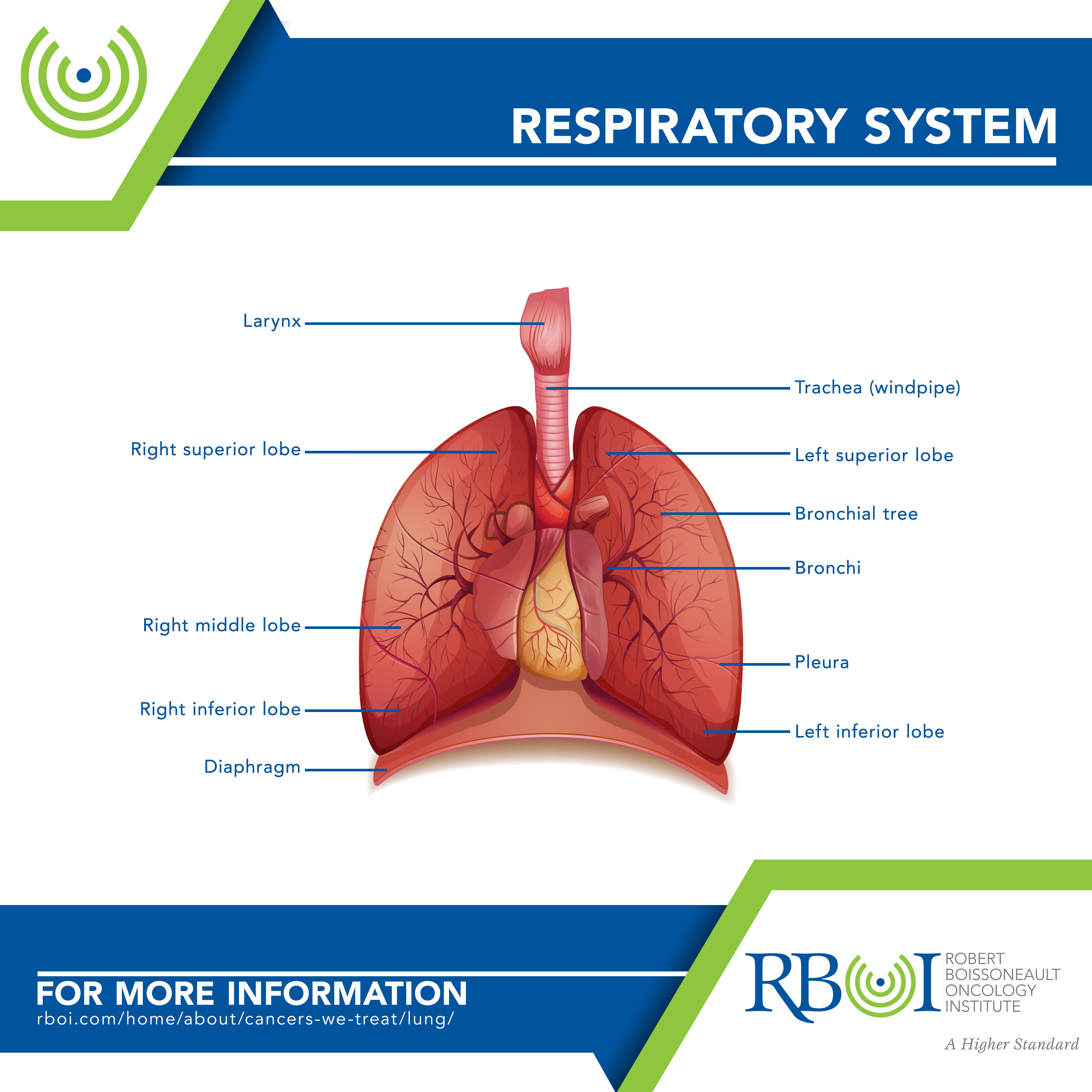Lung Cancer
Lung cancer affects more than 200,000 Americans each year. Cigarette smoking is the main cause of this disease, but it can occur in non-smokers as well. No matter where it develops and whether or how far it has spread, lung cancer is always treatable.
-
Forms of lung cancer
Non-small cell lung cancers (NSCLC) account for about 80 to 85 percent of lung cancers. The three main subtypes of NSCLC are (1) adenocarcinoma, which starts in cells that produce mucus; (2) squamous cell carcinoma, which starts in the cells that line the airways; and (3) large cell carcinoma, which starts in other cells. Other, much less common subtypes include adenosquamous carcinoma and sarcomatoid carcinoma.
Small cell lung cancers (SCLC, sometimes called oat cell cancer) account for about 10 to 15 percent of lung cancers.
Lung carcinoid tumors account for less than 5 percent of lung cancers. They start in neuroendocrine cells and tend to grow slowly.
-
Risk factors for lung cancer
Air pollution, Asbestos, Other gas and chemical exposure, Personal or family history of lung cancer, Previous radiation therapy to the lungs, Radon, Tobacco smoke
Air pollution — Although far less than the risk caused by smoking, air pollution in cities, especially near heavily trafficked roads, appears to raise the risk of lung cancer slightly. Pollution accounts for an estimated 5 percent of all lung cancer deaths worldwide.
Asbestos — People who work with asbestos (such as in shipyards, asbestos mines, mills, textile plants, and places where insulation is used or where automotive brake repair is done) are several times more likely to die of lung cancer. Although government regulations have greatly reduced the use of asbestos in commercial and industrial products, it’s still present in many older buildings and can be released into the air by deterioration, demolition, or renovation. Lung cancer risk is much greater in workers exposed to asbestos who also smoke.
Other gas and chemical exposures — Gases or chemicals at work or in the environment can increase lung cancer risk. These include radioactive ores such as uranium; inhaled chemicals such as arsenic, beryllium, cadmium, silica, vinyl chloride, nickel compounds, chromium compounds, coal products, mustard gas, and chloromethyl ethers; and diesel exhaust.
Personal or family history of lung cancer — If you have had lung cancer, you have a higher risk of developing another lung cancer. Families with a strong history of lung cancer may also be at increased risk. Your risk may also increase if a first-degree relative (parent, sibling, or child) has had lung cancer, especially if diagnosed at a younger age. However, it’s not clear how much of this risk might be due to shared genes among family members and how much might be from shared household exposures (such as exposure to tobacco smoke or radon).
Previous radiation therapy to the lungs — People, especially smokers, who have had radiation therapy to the chest for other cancers, are at higher lung cancer risk. This risk is seen following radiation treatment for Hodgkin disease and following radiation treatment after a mastectomy (though not after a lumpectomy) for breast cancer.
Radon — According to the US Environmental Protection Agency (EPA), radon is the second leading cause of lung cancer in this country, and is the leading cause among non-smokers. Homes and other buildings in nearly any part of the United States can have high indoor radon levels, especially in basements.
Tobacco smoke — Smoking is by far the leading risk factor for lung cancer, and the risk for smokers is many times higher than the risk for non-smokers. The longer you smoke and the more packs a day, the greater your risk, regardless of whether you smoke cigarettes (including low-tar cigarettes), cigars, or pipes. (Smoking marijuana and using electronic cigarettes may also increase lung cancer risk, but more research is needed.) Smoking accounts for about 80 percent of lung cancer deaths. Secondhand smoke (breathing in the smoke from others) is also a risk factor and is thought to cause more than 7,000 deaths from lung cancer each year. Studies have shown that beta carotene supplements further increase lung cancer risk in smokers.
-
Risk factors for lung carcinoid cancers
About 90 percent of this uncommon lung cancer has not been linked to smoking. Risk factors include:
Age, Family history, Gender, Multiple endocrine neoplasia type 1 (MEN1), Race/ethnicity, Tobacco smoke
Age — Although it can occur at almost any age, including in children and adolescents, lung carcinoid cancer is usually found in people about 45-55 years old. This is slightly younger than the average age for other types of lung cancer.
Family history — Most people with lung carcinoid cancer do not have a family history of this disease, but your risk may be increased if others in your family have had this type of tumor. In rare cases, several family members have been diagnosed with lung carcinoid cancer. The overall risk is still low because this cancer is so uncommon.
Gender — Lung carcinoid cancer occurs more often in women than in men.
Multiple endocrine neoplasia type 1 (MEN1) — People with this inherited syndrome seem to be at increased risk for lung carcinoid cancer.
Race/ethnicity — Lung carcinoid cancer is more common in whites than in African Americans, Asian Americans, or Hispanics/Latinos.
Tobacco smoke — Typical lung carcinoid cancer does not seem to be linked with smoking or with any known chemicals in the environment or workplace. However, some studies have found that atypical lung carcinoid cancer, which accounts for about 10 percent of carcinoid cancer cases, may be more common in people who smoke.
-
Symptoms of lung cancer
Fatigue
A cough that does not go away or gets worse. It may include coughing up phlegm, mucus, or blood.
Shortness of breath, which may include wheezing
Chest pain that is often worse with deep breathing, coughing, or laughing
Loss of appetite
Unintentional weight loss
Hoarseness
Infections such as bronchitis and pneumonia that don’t go away or that keep coming back
Most people with lung cancer are diagnosed when the tumor begins to cause problems with parts of the body near the lungs. A lung tumor may also make fluid that can cause a lung to collapse.
-
Symptoms of lung cancer that has spread (metastasized)
More breathing difficulties
Bone pain
Abdominal or back pain
Headache
Weakness
Seizures
Rarely, a lung tumor can release hormones that cause problems such as low blood sodium levels or high blood calcium levels.
Some lung cancers can cause groups of symptoms, called syndromes. These include:
Horner syndrome, which occurs more frequently in non-small cell lung cancer (NSCLC). Symptoms include:
Drooping or weakness of one eyelid
A smaller pupil (dark part in the center of the eye) in the same eye
Reduced or absent sweating on the same side of the face
Severe shoulder pain in some cases
Superior vena cava (SVC) syndrome, which occurs when a tumor presses against the SVC, a large vein that carries blood from the head and arms back to the heart. In some cases this syndrome is life-threatening and should be treated right away. Symptoms include:
Swelling in the face, neck, arms, and upper chest (sometimes with a bluish-red skin color)
Headaches, dizziness, and change in consciousness
Paraneoplastic syndromes, in which hormone-like substances made by the cancer enter the bloodstream and cause problems with distant tissues and organs. These syndromes can be the first symptoms of lung cancer, but can be thought initially to be caused by something other than lung cancer. Symptoms include:
High blood calcium levels (hypercalcemia), which can cause frequent urination, thirst, constipation, nausea, vomiting, belly pain, weakness, fatigue, dizziness, confusion, and other nervous system problems
Excess growth/thickening of certain bones, especially those in the fingertips, which is often painful
Blood clots
Excess breast growth in men
-
How is lung cancer treated with radiation?
External beam radiation therapy (EBRT), delivered from outside the body, is the type of radiation therapy used most often to treat non-small cell lung cancer (NSCLC), small cell lung cancer (SCLC), and lung carcinoid tumors. Types of EBRT include three-dimensional conformal radiation therapy (3D-CRT); intensity modulated radiation therapy (IMRT); stereotactic body radiation therapy (SBRT); and stereotactic radiosurgery (SRS), which is used when cancer has spread to the brain.
Brachytherapy delivers radiation internally. Radioactive material is placed directly into the cancer or into the airway next to the cancer. In people with NSCLC, this method is sometimes used to shrink tumors in the airway. Radioactive pellets (“seeds”) are usually used, and are placed using a bronchoscope or during surgery.
Radiation may be used as the main treatment for both NSCLC and limited stage SCLC (sometimes along with chemotherapy), especially if the lung tumor can’t be removed because of its size or location, if a person isn’t healthy enough for surgery, or if a person doesn’t want surgery.
Radiation may be used after surgery (alone or along with chemotherapy) to try to kill any small areas of cancer that surgery might have missed. People with extensive stage SCLC may sometimes receive radiation to treat residual disease in the chest.
Radiation may be used before surgery (usually along with chemotherapy) to try to shrink a lung tumor and make it easier to remove.
Radiation may be used to treat a single area of cancer spread, such as a tumor in the brain or an adrenal gland. This might be done along with surgery to treat the main lung tumor.
Radiation to the head may be used to lessen brain tumor risk in people with SCLC, which often spreads to the brain. This treatment is called prophylactic cranial irradiation (PCI).
Radiation may be used as palliative treatment to relieve symptoms of advanced lung cancer, such as pain, bleeding, trouble swallowing, cough, or problems caused by the spread to other organs.

Click here to learn more about RBOI’s radiation treatment options
Click here to watch a walk-through of what is involved in radiation treatment at RBOI
More extensive information about lung and other cancers may be found at these sites:
American Cancer Society: Cancer.org
American Society of Clinical Oncology: Cancer.net
National Cancer Institute: Cancer.gov
